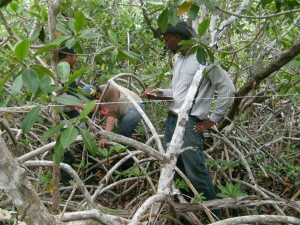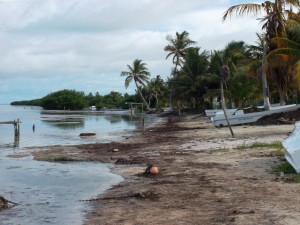
Potential Tour Guide/Nature Defender
One of the standard recommendations for attaining sustainable management and conservation of natural resources, is to involve local communities in their management. In locales as diverse as Botswana, Mexico, and Qatar, the ideas are roughly the same: communities who live near, and depend on natural resources are often those with “lived-in” knowledge about how ecosystems function. Moreover, by virtue of their proximity, they may be ideally placed to function as de facto watchdogs of environmental management. This could also be converted into financial gain if, for example, local residents and users could be hired to act as monitors, or tour guides for ecotourists. The added benefit, of course, is that this process may also contribute to greater environmental awareness – as local users are (presumably) trained as guides/monitors/stewards, they will become more aware of the trophic webs and chains in local ecosystems, and perhaps more ardent defenders. This article, for example, is but one of many advancing this exact point.
However, it should be said that this idea that local communities can or should be drafted into the protection of environmental resources should come with a caveat: there has to be careful attention paid to adequate capacity-building and support. Establishing management programs that place additional, inadequately compensated responsibilities on local communities – particularly when they are marginalized – may either be unfair socioeconomically, or problematic environmentally. The fact of the matter is: monitoring natural environments is Hard Work.
Here’s an example: on Wednesday June 14th, I went out with a group of paid monitors hired by Simbiosis SA de CV in Chetumal, Mexico to monitor the mangrove forest near the coastal community of Xcalak in the state of Quintana Roo. This monitoring was done, mind you, in support of a law approved in 2007, protecting mangrove zones at the federal level – they have a wide impact on the health of coastal ecosystems, including coral reefs, juvenile fish, and coastal integrity. The monitors, all three of whom came from an ejido near the politically marginalized municipality of Carillo Puerto were paid about US$20 for a day’s work. So this is what it entailed:
As soon as we stepped off the road, into the outer zone of the selva, we were surrounded by small armies of mosquitos. And worse. Large, ominous flies, about two inches long, buzzed threateningly, waiting to alight and draw blood. We moved off at a rapid clip, and I saw a veritable cloud of them, hovering behind the man in front, tracking him through low-lying forest: I imagine we all had one.
Our speed declined rapidly when we got to the first start of the mangrove swamp. The puddles of rank, foul-smelling, foetid, black water were small enough at first – only ankle deep. (I only began swearing when I realized that my allegedly waterproof Timberlands were NOT). Then knee deep. Then thigh deep. And this, mind you, with the swarms alighting when they could, always finding that spot that the repellant didn’t cover. And with half-rotted branches, and putrefying gunk underneath the black, turbid water. And having to climb over and under bone-white roots of the mangroves, tangled together like a corpse’s fingers. Footing was, to say the least, insecure.

Like This, Only With More Roots
It took us about an hour to get to the first monitoring zone. At that point, we were all soaked from swamp water and sweat, and stinking. At that part, mercifully, there weren’t many mosquitos, and few black flies. However, a gorgeous, tiny golden bug alighted on my knuckles, and only when it flew off did I notice the blood. Monitoring itself was tedious: you mark a tree (we were looking at species of mangle rojo, or Rhizophora mangle) with a piece of tape, then measure the diameter of the trunk, estimate its height, its cupula size, and count how many propágulos it has. Over, and over, and over again. “¿Diámetro?” “5cm.” “¿Altura?” “3.5m.” “¿Mande? ¿2.5 dijiste?” “No, son 3.5m.” Etc. Then it rained. It poured. We were soaked again. Fortunately, this at least broke the heat of the Yucatán in summer.
Now, it was absolutely fascinating. Bugs, plants, and critters I’d never seen before. Butterflies broke up the monotony of the green and green over a greener green. After the rain, flourescent green spots appeared on some of the roots of the mangrove. Occasionally, geese flew overhead, and we heard the ceaseless moving of iguanas and lizards right out of sight.
But still, this is not easy work. 5 hours, maybe in the mangrove zone, and two hours through very difficult terrain. To this day, I don’t understand how we didn’t get lost – you can’t cut paths in the mangrove, because it’s a protected species, and while there were some strung up lines and markers at some places, these were few and far enough between that you could only navigate with an already-present real knowledge of the area. And if you got injured or lost in this area, you would be effed. I asked one of the monitors, a young guy from the ejido, why he did this, if he liked the environment a lot, or something? No, he said, it’s just a job, and he has no idea what it’s for. A job that pays $20 a day.
Now, these things have to be done, clearly. But NGOs, project directors, and activists have to be really careful about how community-based management programs are designed. They can be a source of empowerment and development, but they are additional responsibilities and we should recognize this.














